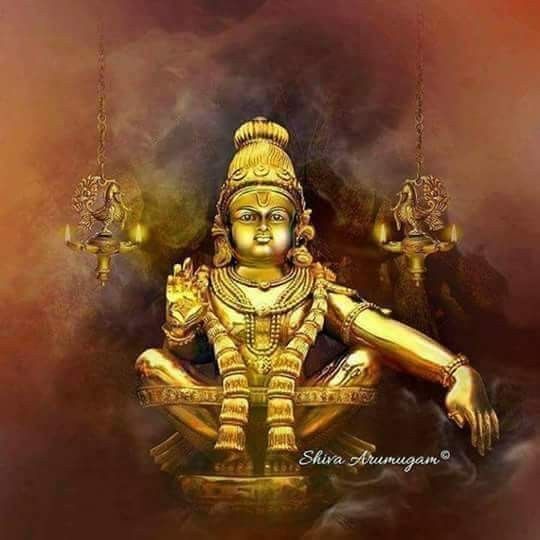
Contents:
Sabrimala temple is a temple complex dedicated to Lord Ayappan , who is an epitome of Dharma truth and righteousness and the son of Shiva and Mohini ( female manifestation of Vishnu ). It is located at Sabrimala hills in Pathanam district of Kerala.
Ayappan is a celibate God and it is believed that the devotees should maintain celibacy for 41 days before visiting the temple.
Sabrimala Location
The temple is surrounded by dense forests and mountains and is situated at an altitude of 4134 ft above sea level. Its unique location and rareness makes it one of the most visited temples in India.
The main temple is built on a plateau which is 40 ft high.
Deity called Shasta have been a major part of history of South India. In the Sabrimala temple Shasta is worshipped with the name Ayappan .
Shasta is venerated from Shiva and Vishnu and is worshipped in various forms across the world.
Shasta can be married or celibate , but Ayappa is a celibate deity.
It is believed that the prince of Pandalam dynasty ( who was an incarnation of Shasta) meditated at the Sabrimala temple and attained salvation . Since then the temple had been run by the Pandalam dynasty .
In 1821 , the Pandalam dynasty was merged with the royal kingdom of Travancore and 48 temples along with the Sabrimala temple were now managed by the Travancore kingdom.
There are 18 sacred steps which are main stairway to the temple . A travel kit or pouch known as ‘ Irumudikettu ‘ is necessary for crossing these sacred steps. Those who do not carry this sacred pouch have to go through the northern gate .
Deity of the Temple- Ayappan
Ayappan , also called Dharmashasta and Manikandan is the main deity of the temple in the yogic pose. He is visited by millions of devotees, who climb the hill barefoot, especially in the month of December.
Ayappan is the son of Shiva and Vishnu ( in the form of Mohini) . So , he is also called ‘ Hariharsudhan’ , the son of Hari and Hara . He was born to kill the demoness named Mohini. He is depicted as a handsome celibate man , wearing a bell around his neck . He is a symbol of ethics and righteousness.
He is respected by the people of other communities like Muslims and Christians as well.
Irumudikettu
It is a travel pouch which has two parts . The term ‘Iru’ means two and kettu means knot. The front compartment is called Munmudi and consists of items for Lord Ayappa. The back part is called Pinmudi and contains items for personal use .
Items in the Sacred Travel Kit
- Currency coins
- Cleaned coconut to fillmghee
- Rose water
- Malar
- Agarbathi ( incense sticks)
- Camphor
- Rice
- Jaggery
- Betel leaves
- Avil
- Beaten rice
- Arecanut pieces
- Turmeric powder
- Sandal paste
- Vibhuti
- Pepper
- Towels
- Clothes
Temple Rituals
Mandal Kaalam
The pilgrimage of Sabrimala is altogether of 41 days . This period is known as Mandal Kaalam. It starts from the first day of Vrischika month of Malayalam year (month of Scorpio) and ends on the 11th day of Dhanu month (the Month of Sagittarius).
Harivarasanam
It is a lullaby written by Konnakath Janaki Amma in 1923, the daughter of then priest of the temple . Every night this song is recited in the temple before closing the door.
Prasadam
The prasadam at this temple is prepared using rice ,ghee ,sugar and jaggery. These consists of a Kheer called Arvana Payasam, and a rice pancake called Appam.
Makar Sankranti
Sabrimala is the place where Lord Rama met Sabri , the tribe and ate her tasted fruits. There Rama saw a person meditating under a tree , and came to know that he was Shasta . Seeing Rama, Shasta got up and greeted the prince of Ayodhya . This day is called as Makar Vilakku or Makar Sankranti . It is believed that on this day Lord Ayappa leaves his meditative state and bless his devotees.
A holy star that appears before the aarti on Makar Sankranti is called Makar Jyothi.
The methodology of worship at the Sabrimala temple is a combination of Shaktism , Vaishnavism and Shaivism.
Dispute over Women Entry
According to the customs of Sabrimala temple ,the entry of women in their menstruating years ( age group 10 to 50) wass prohibited inside the place of worship.
In 1991 , the custom was challenged in the Kerala High court and it was ruled out that the custom was constitutional and justified, as it was practiced since a very early time.
In 2006, Indian Young Lawyers Association , filed a PIL in the supreme court challenging this custom arguing that it violates the right to equality and freedom of religion for female devotees.
On October 13, 2017, the matter was referred to a four members constitution bench including Chief Justice Deepak Mishra , justice R. Banumathi , Justice Indu Malhotra and Justice Ashok Bhusan.
On 28th September 2018, the bench delivered the judgement.
Verdict of the Court
In a 4:1 majority, the court ruled that Sabarimala’s exclusion of women violated the fundamental rights of women between the ages of 10-50 years and Rule 3(b) of the Public Worship Rules was unconstitutional. Justice Indu Malhotra delivering a dissatisfied opinion observed that in a secular polity, it was not for the Courts to interfere in matters of religion and the same must be left to those practicing the religion.